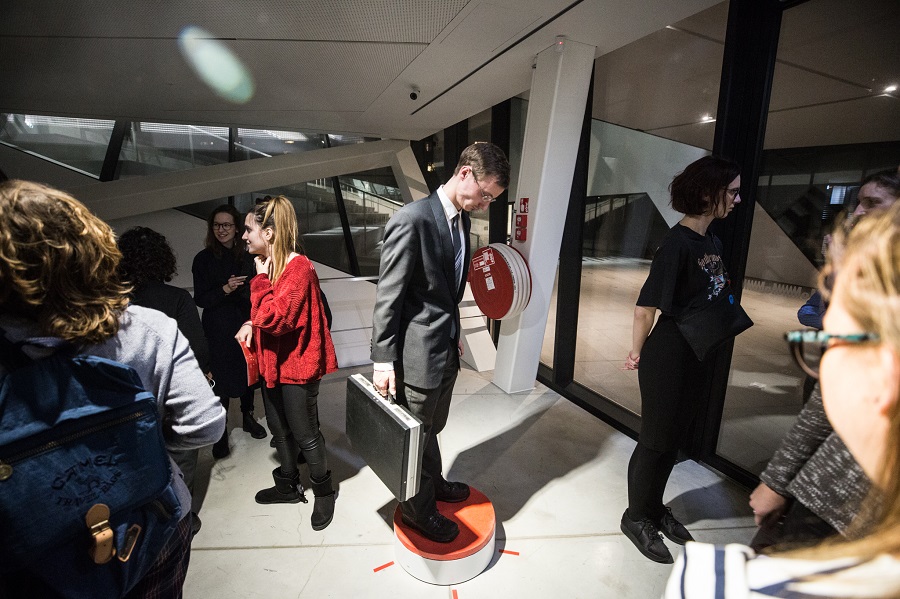Starting Point: New interactive exhibition opened at MO Museum

New interactive exhibition opened at MO Museum: visitors invited to experience art through authors' stories
A new interactive exhibition “Starting Point” has been opened in the Small Hall of the MO Museum (MO), which invites visitors not only to look at art, but also experience it. It brings together artists, curators, experience designers, and sound directors of different fields from Lithuania and abroad. This cooperation has resulted in works of video art, painting, photography, and art installation that all invite the viewer to touch, lift, and hear artists speaking about their starting point in the creative process.
Perceiving art through experience
According to the representatives of MO, in art museums we often find various restrictions, like “do not touch” or “do not run”, but far less often the visitor is given the opportunity to actively participate in the exhibition – to experience and feel it.
“During the first exhibition we noticed that visitors are very curious and want to do something. People want to touch or taste milk in the glass of Jurga Barilaitė’s “Storm in the Glass” or redistribute sow thistles in the artwork by Linas Katinas“, says Milda Ivanauskienė, Director of MO. “Since our mission is to involve people in perceiving and experiencing art, we have brought together a team of young promising art curators and interaction designers, who studied in London. They all agreed to experiment with different ways of engaging visitors into the learning process of contemporary art”, M. Ivanauskienė notes.
Exhibition team of young Lithuanian talents
For the exhibition “Starting Point” MO has gathered young Lithuanian talents, who work in various fields both in Lithuania and abroad. The exhibition presents works of video art, painting, photography, and art installation, created by six authors: Geistė Marija Kinčinaitytė, Eglė Ulčickaitė, Liudas Parulskis, Jurga Barilaitė, Vytautas Viržbickas, and Andrej Polukord. The exhibition and the interactions were implemented by co-authors of art projects, recognised in Lithuania as well as abroad: curators Gabrielė Radzevičiūtė and Marius Armonas, interaction designers Justas Motuzas, Lukas Valiauga, and Inga Galvanauskaitė, and sound director Antanas Dombrovskij.
“Finding and revealing talents in Lithuania have always been one of our values. Therefore, the exhibition team of diverse members from various fields is sort of an innovation in the cultural and artistic environment that will encourage viewers to look into contemporary art in a different way. We are glad to assist a young team of artists whilst implementing their modern initiatives and bringing art closer to each of us”, says Rolandas Viršilas, CEO at Švyturys-Utenos Alus, which is the main sponsor of the exhibition.
Artworks complemented by interactive objects
The exhibited works are going to tell several stories: photographs of Kinčinaitytė will invite to wander between Mars and Earth, video projection by Parulskis – watch the city on the run, and “Boom Barrier“ by Polukord – feel the impediment of moving forward.
Visitors will also discover that each piece of art is complemented by special interactive design objects, and by touching or lifting them, or by performing some other action, viewers will find out the starting point of each artist in his/her creative process. According to the authors of the exhibition, the opportunity to make objects “talk” enables deeper engagement into the cognitive process.
Interaction designers believe it is not enough to observe contemporary art – people want to learn more about it, and this can be achieved through interactions. Designer Justas Motuzas, who worked with his colleagues Inga Galvanauskaite and Lukas Valiauga, emphasises that “creating exhibition experience is not about new technological solutions but about the idea and the story it tells. Having this in mind, we choose the most appropriate technology that helps to show and experience the story more“.
“I will not tell you, experience for yourself”
Exhibition authors do not seek to create a specific impression, but rather leave visitors to experience everything themselves. “If the visitor of the exhibition will tell his or her friend “go there, I will not tell you anything, find out yourself”, then we will have reached our goal,” they note.
One of the curators of the exhibition Gabrielė Radzevičiūtė was asked for a piece of advice for a visitor with little knowledge about contemporary art. “Whilst looking at works of contemporary art, I would advise not to back oneself into a corner and to forget all the prejudice. Contemporary art is diverse, it speaks of various processes that take place within us, or, on the contrary, it can speak about things that are strange and remote for us. At a certain point, they may look both interesting and uninteresting, and after some time they may seem to have a different meaning than that perceived initially,” says G. Radzevičiūtė, one of the curators of the interactive exhibition at MO.
Without any prejudice and correct answers
“Contemporary art is a form of thinking. It only provides a thought, an idea, and the viewer can himself decide whether the work of art approves it or not”, adds curator Marius Armonas.
According to curators, what may have great effect upon perceiving contemporary art is prejudice and lack of trust in one’s own knowledge (i.e., do I know enough to understand it “the way I am supposed to”?) They claim that mere curiosity and self-motivation for search are enough. Become a child – after a run through the exhibition hall they always discover things, that make them laugh or are of interest. Thus, everyone should keep in mind that contemporary art is not created for a narrow group of intellectuals. In order to understand it, all you have to do is to be open.
The exhibition “Starting Point” is open for visitors from 8 March until 14 April in the Small Hall of MO Museum.
Photos: Tautvydas Stukas and Eglė Jasiukaitytė.